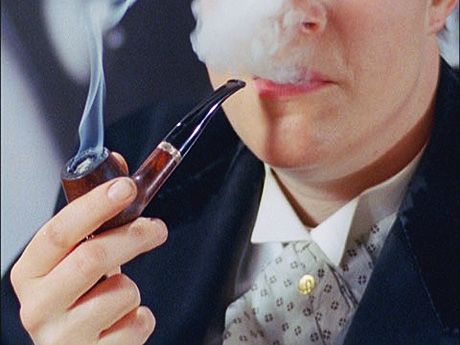Pauline Boudry / Renare Lorenz, Normal Work
Installation with film and
13 photographs, 2007
Performer: Werner Hirsch
Information on the film:
Film Material: 16 mm. / DVD
Length: 13 Min. Loop
Backdrop Photograph: Del Lagrace Volcano
Camera: Bernadette Paassen Sound: Karin Michalski
Sound Design: Rashad Becker
Information on photographs:
13 Phtotographs from 1860 until 1904 of Hannah Cullwick
Courtesy of: Munby Archive, Trinity College Cambridge
http://www.boudry-lorenz.de/
Hannah Cullwick not only cleaned from early in the morning to late in the evening in various households, she also produced a series of remarkable staged photographs, numerous diaries, and letters. These materials present her strengh, her muscles, and her big, dirty hands: embodiments of her gender that were obviously directly connected with her working practices and which she was very proud of. Hannah Cullwick's portraits and self-portraits, which show her not only as a domestic servant, but also in „class drag“ or „ethnic drag“, where part of a sadomasochistic relationship that she had with Arthur Munby, a man from the bourgeois class. Interestingly, it was the elements of her hard work in the households that provided the material for their shared SM scenes. The work that Cullwick carried out as a domestic servant was later restaged together with Munby in their meetings in his home. The crossings of social positions that she staged in the photographs - which show her as a bourgois woman, as a young bourgois man, or as a slave in blackface - partly also play a role in Cullwick's everyday life, for instance when she traveled with Arthur Munby in „bourgeois drag“. The photographs can be understood as a technology to control these crossings, or to reflect on the great efforts and constant deliberation that were connected to them. The film „normal work“ asks whether the crossings of social hierarchies of class, gender, and „race“ that Hannah Cullwick staged and that she obviously desired have today become generalized into a paradoxical requirement in the field of labor.
In the film we watch the performer Werner Hirsch / Hannah Cullwick attempt to imitate Hannah Cullwick's poses as precisely as possible.
Werner Hirsch / Hannah Cullwick orients him/ herself to his/her memory, to a mirror, or to a „model“ that is not in the image, or to instructions that are called out to him/her, also from outside the space of the frame.
Since two different historical moments (Victorian times and the present day) and two places of expression meet each other in the film, contradictory references arise. The historical photographs are placed in the context of contemporary drag performances and reworkings through gender binarity. Taken in the other direction, contemporary performances are placed next to a historical predecessor, in which the relations between sexuality and work were negotiated.

